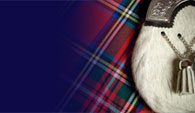Highland Fling
History: The Highland Fling is said to have been inspired by the sight of the stag curvetting in the distance. The raised arms and finger grouping of the dancer represent the antlers of the stag. Another story is that the Highland Fling was originally danced on a shield or targe perhaps accounting for the precise stepping on the spot.Interpretation: The Highland Fling is an exceptionally lively and virile dance, showing the natural energy of the youthful Highlander and is a spirited test of physical skill.
Execution: All movements must be clean cut and controlled with Flinging at the same height around the leg. The knees are well splayed and held straight in 2nd and 4th positions with a slight suggestion of a pause on open point positions. The supporting foot must be maintained at its correct turnout and be used in a high ball position. The balance is centered over the supporting foot and the body bears a dignified upright stance.
Timing and Rhythm: The Highland Fling is danced in Strathspey time, 4/4 but attention must be paid to the "&" count to interpret the melody rhythm which has a "snap" peculiar to Strathspey music such as Monymusk, Marquis of Huntly.
Steps: Flinging is the basic movement. Steps must be recognized by the main foundation movement within the step, this often being combined with Flinging thus giving the steps the characteristics of the Highland Fling.


